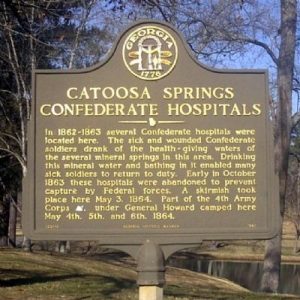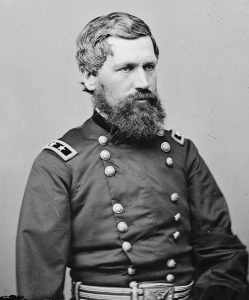Things I have learned on the way to Atlanta
Soldiers are tourists. Even in the midst of war, they explore things. One of the more interesting passages concerning this phenomenon has to do with a popular pre-war resort in northern Georgia: Catoosa Springs. Once the war began, the Confederates took over the resort for a hospital, and on May 1, the Federals occupied it for a short time at the beginning of the Atlanta Campaign.


General Oliver O. Howard set up his headquarters in the Catoosa Springs Hotel, a pre-war resort and spa, located in a pleasant vale of “numerous sulfur springs and a magnificent grove of cedars, pines, oaks, and maples.” There were fifteen acres of buildings, including the hotel and many smaller cabins, making it ideal for a corps commander’s uses. Charles Kingman, a 19-year-old private in the 88th Illinois infantry, was certainly impressed. Writing to his mother, Kingman wryly noted that “the Catoosa Springs, 37 in number, are a great curiosity, [with] a strange variety of waters, sulphur springs of all kinds, vis. The red, blue, excelsior, &c. [I]n fact, mineral waters of all kinds are to be found on the estate known as Catoosa Springs. A splendid hotel, bowling alleys, ball room, out houses &c. are still in good repair, Gen. Howard making the hotel as his headquarters. I should judge the springs have been a place of fashionable resort for the wealthy class all over the Confederacy. Citizens say that the hotel barnes had accommodation for about 1200 boarders the year round, pleasure seekers, invalids, and I expect husband-seeking damsels.”[1]
Members of the 81st Indiana, in David Stanley’s division, also found time to explore the springs, although with a more jaundiced eye. Corp. George Morris described the place as being “formerly a fashionable watering place for rich Southern people. We moved in on the grounds, halted and stacked arms and waited for further orders. This was a beautiful place and said to contain eighteen different kinds of water. Every spring had a name over it. We wandered around among them all, testing each, but we came to the conclusion that they were all the same kind of water.”[2]
Since 1861, the resort served as a Confederate hospital, and Howard was not the first general to take up residence. It hosted General Bragg and his wife Eliza the previous August, just before Chickamauga. The Braggs, both suffering from assorted illnesses, came for the waters’ medicinal properties. For his part, Howard found it “a splendid Watering place [of] tremendous wooden houses, [and] beautiful mountain scenery.”[3]
Here is a link from a local paper describing the history of the resort:
And if you are seeking “husband-seeking damsels,” you now know the place to see and be seen in North Georgia!
[1] William J. Beaudot, The 24th Wisconsin Infantry in the Civil War, The Biography of a Regiment (Mechanicsburg, PA: 2003), 292; “Dear Mother,” Catoosa Springs, May 6, ’64, Charles Kingman Letters, personal collection of Caroline Linde, Glenn Ellyn, IL.
[2] George W. Morris, History of the Eighty-first Regiment of Indiana Volunteer Infantry in the Great War of the Rebellion 1861 to 1865 Telling of its Origin and Organization; A Description of the Material with which it was composed; Its Rapid and Severe Marches; Hard Service and Fierce Conflicts on Many Bloody Fields. (Louisville, KY: 1901), 83.
[3]O. O. Howard to wife Lizzie, May 5, 1864, O. O. Howard Papers, Bowdoin College, Brunswick, ME.
Before reading the above account of Catoosa Springs (where it appears the departing Confederates forgot to erect, “Beware, Bad Dog!” signs, to frighten away Federal invaders) the only mineral springs of which I was aware, of Civil War significance, were those sited at Bladon Springs, Alabama, 80 miles North of Mobile, where General PGT Beauregard retired in June 1862 in order to “regain his health,” and ended up losing his Army of the Mississippi.
Thanks to Dave Powell for a compelling footnote to the Atlanta Campaign.